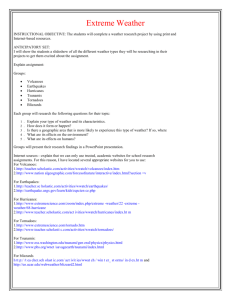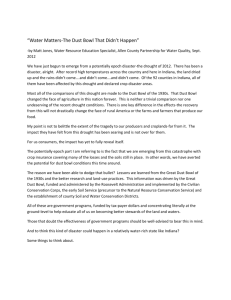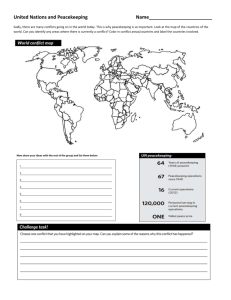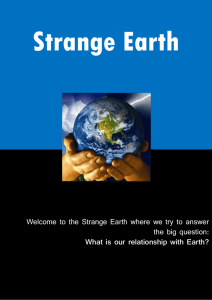Natural Disasters - Teaching with Primary Sources at Illinois State
advertisement
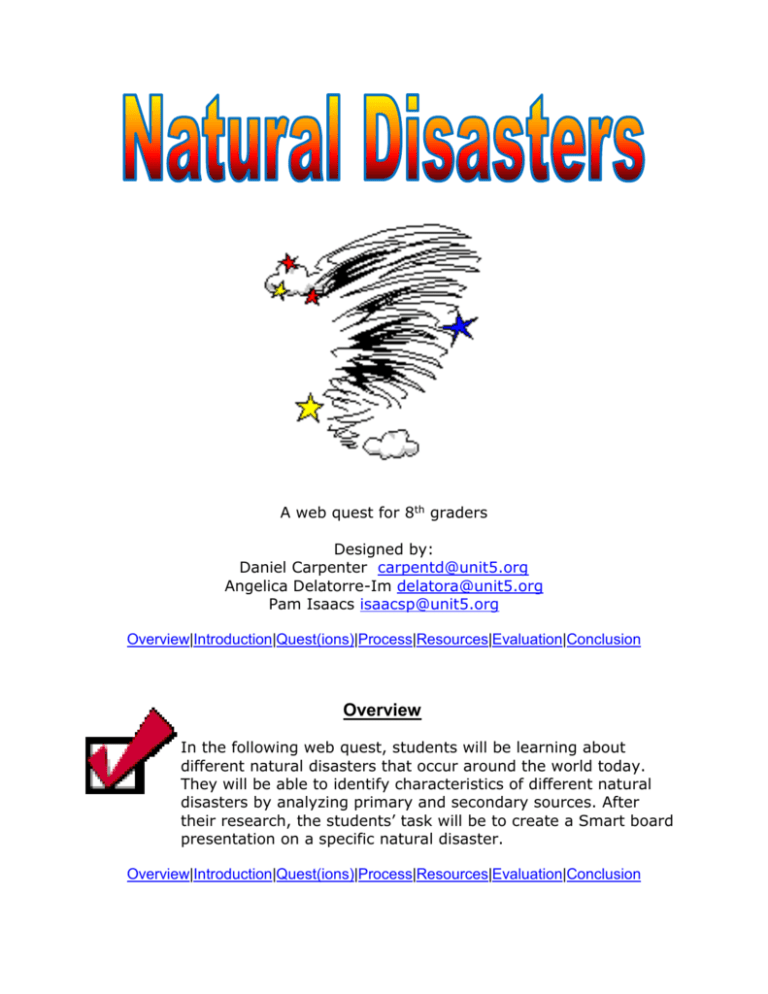
A web quest for 8th graders Designed by: Daniel Carpenter carpentd@unit5.org Angelica Delatorre-Im delatora@unit5.org Pam Isaacs isaacsp@unit5.org Overview|Introduction|Quest(ions)|Process|Resources|Evaluation|Conclusion Overview In the following web quest, students will be learning about different natural disasters that occur around the world today. They will be able to identify characteristics of different natural disasters by analyzing primary and secondary sources. After their research, the students’ task will be to create a Smart board presentation on a specific natural disaster. Overview|Introduction|Quest(ions)|Process|Resources|Evaluation|Conclusion Introduction Natural disasters are extreme, sudden events caused by environmental factors. They can happen at any time, often with little or no warning and they can cause serious injury to property and lives are often lost. Try as we might, we cannot control nature. If we want to protect ourselves we must become educated to what nature is capable of and what we can do when it unleashes its fury. Have you seen the TV show “Extreme Make-Over: Home Edition” where a crew goes to a needy family, sends them on vacation, and then rebuilds the house in 7 days? You are going to be a part of a catastrophe research team and investigate a prior natural disaster. You will then present your information to the class in the form of a presentation to share with the class. Overview|Introduction|Quest(ions)|Process|Resources|Evaluation|Conclusion Quest(ions) and the Task There are several tasks that you are required to complete prior to starting on your Smart board presentation on a specific event when a natural disaster occurred. Tasks #1. Study the following primary sources listed below and complete the Photo Analysis Worksheet on the photographs. On some photographs you will need to click on picture to make the image larger. a. b. c. d. e. f. San Francisco Earthquake & Fire 1906 Goose Creek, Galveston Bay 1919 Galveston Disaster in Texas 1900 Flood in Lima, Ohio 1913 Dust Bowl Liberal, Kansas 1936 Eruption of Volcano in San Salvador 1917 #2. #3. After analyzing the photographs—now you will have the opportunity to view several videos on natural disasters that have occurred in our world. You may view these on National Geographic: Eye in the Sky. Are you ready to learn more about natural disasters such as: Dust Bowl, earthquakes, floods, hurricanes, tornadoes, and volcanoes? Please answer the following questions below. Use the hyperlink and/or other websites located in the resources to find your answers under each natural disaster. Dust Bowl Earthquakes Floods Hurricanes Tornadoes Volcanoes Questions for each natural disaster: Dust Bowl 1. When did the Dust Bowl happen? 2. What was the Dust Bowl and what caused it? 3. In what regions/areas did the Dust Bowl affect? 4. What was Black Sunday? 5. How did people survive this natural disaster? 6. What would you have done had you lived during the Dust Bowl? 7. How do you think your life would have been affected by the Dust Bowl? Earthquake 1. What are the causes of an earthquake? 2. What is a tectonic plate and fault? Observe the animation of faults. 3. Define the following terms: epicenter and hypocenter? 4. What is a seismograph and seismogram? Observe the animation of waves. 5. What type of hazards do people face during earthquakes? 6. What do people do to prepare for earthquakes? Floods 1. 2. 3. 4. 5. What causes a flood? What tool do meteorologists use to determine or track rainfall? What is El Niño and how does it affect flooding in the U.S.? What is a 500 year flood? When and what happened in the flash flood that ripped through Fort Collins, Colorado? 6. Learn about what it is like to experience a flood from Real Stories All Over the World. Explain people’s thoughts and feelings. Hurricanes 1. 2. 3. 4. 5. What is a hurricane? How do they form? Where do they form? What are the stages in the development of a hurricane? What are the categories of hurricanes and their corresponding wind speeds? Tornadoes 1. What causes a tornado? 2. Where do most tornadoes occur and when are they most frequent? 3. What are some tornado variations? 4. What are waterspouts? 5. How do tornadoes form? 6. What are some tornado safety precautions you can take? Volcanoes 1. 2. 3. 4. 5. 6. #4. What causes volcanoes? What are the three types of volcanoes? What effects do volcanoes have? Can we predict when a volcano will erupt? Do volcanoes do anything good? Which volcano has killed the most people? Now that you have become an expert on natural disasters, you may work individually or with a team member to investigate further on a natural disaster that has occurred in our world. Use the rubric to guide you with your layout and content of your presentation. #5. After completing the project, be prepared to share your presentation to the class. Overview|Quest(ions)|Process|Resources|Evaluation|Conclusion Process 1. You may work with a partner to complete the Photo Analysis Worksheet and view the National Geographic: Eye in the Sky video clips. Then individually you will answer the question(s) below each natural disaster. Be sure to use the hyperlinks and websites on the resources to answer these questions. When you have completed this task you may work individually or with a team member to investigate further on a natural disaster that has occurred in our world. Use the rubric to guide you with your presentation. Then we will come together as a group and share your presentation with the class. 2. Options on how to present your information to the class: Power Point Presentation Smart board Notebook presentation Web Page (Frontpage) Overview|Introduction|Quest(ions)|Process|Resources|Evaluation|Conclusion Resources Resource Table Dust Bowl 1. http://memory.loc.gov/learn/features/timeline/depwwii/dustbowl/dustbowl.h tml Earthquakes 1. http://earthquake.usgs.gov/learning/glossary.php Hurricanes 1. http://www.pbs.org/wgbh/nova/sciencenow/3204/02.html 2. http://www.floridadisaster.org/bpr/EMTOOLS/Severe/hurricanes.htm 3. http://www.howstuffworks.com/hurricane.htm 4. http://www.fema.gov/kids/hurr.htm 5. http://www.weatherwizkids.com/hurricane1.htm Tornadoes 1. http://www.pbs.org/wgbh/nova/tornado/ Historical Fiction Books on Natural Disasters 1. http://memory.loc.gov/learn/lessons/00/nature/resource.html 2. http://doi.contentdirections.com/mr/greenwood.jsp?doi=10.1336/15630886 14 Novels/Literature Hesse, Karen. Out of the Dust. Scholastic, 1997. Overview|Introduction|Quest(ions)|Process|Resources|Evaluation|Conclusion Evaluation Please click on rubric to review the criteria on which your grade will be based. The following sites are examples of presentations/projects. Use these to guide you. 1. Example #1 (student sample) 2. Example #2 (student sample) Overview|Introduction|Quest(ions)|Process|Resources|Evaluation|Conclusion Conclusion Do you know when or what to do if disaster strikes? Our world is always in a state of uproar. You will never know when another major hurricane will hit. Ships will sink, houses will be destroyed, shorelines will take new shapes, leaving thousands of victims in its path of destruction. Today, earthquakes occur somewhere on earth about every 30 seconds. Tornadoes hit the U.S. like no other country. No one knows when the next natural disaster will happen. But unfortunately it will! Disaster preparation saves lives. Knowledge helps survival. Knowing what to do, when to do it, and how to do it, could save your life or the life of someone else. Your greatest chance for survival depends on disaster awareness. Congratulations! You have researched a great deal of information about natural disasters in our world. You have put together a wonderful presentation. Overview|Introduction|Quest(ions)|Process|Resources|Evaluation|Conclusion
